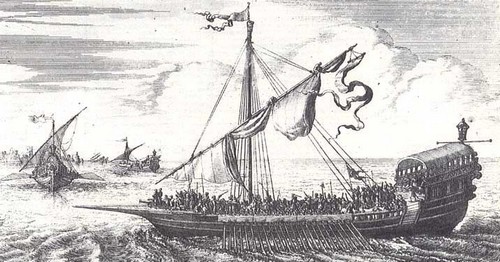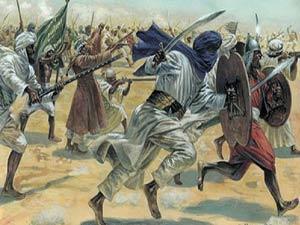Historical Eras

Islamic Conquest of Alexandria

Amr Ibn Al’as easily took the Fort of Babylon as he invaded Egypt and proceeded in 641 A.D. (21 Hijri) to Alexandria where local Copts welcomed him and offered him support. Copts served as supporting arms for Arabs. Between the end of 20 Hj and the beginning of 21Hj,, Muslims entered Alexandria
Alexandria as seen by the Arabs
Ibn Alhakam, the Egyptian historian, described Alexandria as seen by the Arab invaders as composed of three districts separated by walls: The Egyptian, the Roman and the Jewish districts.
Huge cisterns were filled with fresh canal water during the months of the flood and can be still seen around in Alexandria today. Shopping arcades were constructed on arches and awesome columns and pillars across the city.
Ruins of the famous Alexandria lighthouse – one of the seven Wonders of the World – can also be found as a square foundation near the Fort of Qait Bey in Anfoushi District. Another remarkable architectural monument that is ranked after the lighthouse, is the famous Pompey's Pillar which is a unique cylindrical structure.
Among the most famous landmarks of Alexandria are two churches: the St. Mark Church (Morkoseya) and the Cesarean Church. Both churches were adorned with an obelisk dating from Pharaonic times. The obelisks were later transferred to New York and London respectively and have given the names of Obelisk Street to the area where they were placed.

Alexandria After the Muslim Conquest
Amr Ibn Al'as is claimed to have chosen Alexandria to be the capital of Egypt in his era, but the Caliph back then, Omar Ibn Al Khattab, is said to have refused the idea when he knew that Alexandria was cut off from the rest of the Arab world with the yearly Nile floods. Over time, many wealthy Romans left Alexandria causing a major economic recession. The remaining Romans endured difficult times, while Alexandrians prospered and led a more comfortable life at the social and personal levels.
Only four years later, during which Alexandria had reached a level of stability, a large Roman fleet raided Alexandria and Romans took over Alexandria. The Romans marched on to the city of Fustat, but Amr Ibn Al'as stopped them at the town of Nikius on the banks of the Nile, close to the city of Menuf. The battle was fiercely fought on land and on the river and ended up with the defeat of the Romans, who fled towards Alexandria. Many Romans were killed by Amr Ibn Al'as's forces. However, when survivors begged Amr Ibn Al'as for his mercy and to spare their lives, he did. Today, at the site where Amr Ibn Al'as spared the life of those Romans, lies the Rahma Mosque (mercy mosque). The mosque tells of the mercy Ibn Al'as had over his defeated enemies.

Alexandria in the Omayad Era
The Caliph of Damascus – Moaweya – had a keen interest in merchant fleet and, under his rule, Alexandria became a blooming harbor for Arabs from the Levant and the Arabian Peninsula which further encouraged Arab culture, Islamic architecture and the increase in the building of mosques.
The Commander of Fostat – Etba Ibn Sefyan – brother of the Caliph chose Alexandria as second capital of Egypt and ruled from there.
.jpg)
Alexandria in the Abbaside Era
Under the Abbasids, Egypt’s relations with the Caliphate remained virtually unchanged becoming a state under the dominion of Bagdad instead of being under the authority of Damascus, and Alexandria continued to thrive unaffected by this change.
It wasn’t until 760 A.D. (142 Hijri) that Alexandria took a slightly different status: The Caliphate Heir – Abu Gaafar Elmansur – took interest in Africa and, under the rule of the Commander of Egypt – Mohamed Ibn Elash’ath – Abilkhatab Abdel A’li Elmaafry led an army to battle the Tripoli Khawarej who were renegades from the area of Elabadeya, but he was defeated and left the city of Fostat to Alexandria. From there, he led military operations in Morocco, turning Alexandria into a meeting point between East and West.

Alexandria as an Andalusian Emirate
With rising unrest in the city of Fostat, Abdel Malek Elkhozaye was restored as Commander in 814 A.D. (199 H) after having been evicted by El Ma’moun, but unrest in Alexandria continued until it split from the authority of Fostat for more than 10 years. Alexandria flourished as ships brought in more emigrants and Andalusian warriors, who chose Alexandria as their base for support of military operations in the Middle East.
Within the chaos of riots and unrest, a Sufi group rose under the command of Abdel Rahman Elsufi to rebel against the Commander of the City. Partnering with the Andalusians, the Arab Lakhmeys of Alexandria nurtured their ambitions to take control of the city and, gathering about 10’000 men and mercenaries, they walked over the Palace of Amr Ibn Helal Elhadigy in 816 A.D. (200 H). After a short siege, they killed everyone in the Palace, including Am Ibn Helal, but the alliance between the Andalusians and the Arabs was short lived: Soon, the Andalusians overcame the Arab Lakhmeys in a battle and took control of Alexandria. Under the command of Abu Abdel Rahman Elsufi, corruption sweltered and Andalusians were forced to evict him and retake control of the city.
In the meantime, Fostat fared even worse with a fight between Elamin and Elma’mun over the Abbaside Caliphate. However, as unrest continued, Abbaside forces from the area of Kharasaneya besieged Alexandria in 827 A.D. (212 H) and succeeded in ousting the Andalusians.
Unrest spread across the Governorate of Sharkeya, Northern Delta and Alexandria, until Elmo’tasem (Ibn Elrashid) armed with Turkish soldiers stormed Alexandria and Northern Delta in 829 A.D. (214 H), arresting and suing Al Afshin – head of the Caliphate – and overcoming resistance from mercenaries and revolutionaries on his way to Alexandria which he took in a bloodless invasion on January 28, 832 A.D. (19 Zul Hija 216 H).
Under the rule of Almo’tasim, Turkish immigration increased with military and craftsmen flooding Alexandria, which further weakened Arab presence in key areas, including the army. In 833 A.D. (218 H), Arabs were virtually excluded from the military to be replaced by Persians and Turks who occupied key posts in the government and the police.
In 856 A.D. (242 H), not a single Arab was to be found in command and a resurgence of violence started in 866 A.D. (252 H) under the command of Gaber Ibn Elwalid Almedelgy. Forces of Yazi Ibn Abdalla Eltorky – ruler of Egypt – and the vice-ruler were bitterly defeated as neighboring Muslims from Alshatar and Alfattak, and Whites, Blacks, Sunnis and Shiites from the surrounding areas gathered to give momentum to the attack. Victory lasted short as the Caliphate in Iraq sent the Turkish Commander Mozahem Ibn Khakan and forces to crush the rebellion of Gaber and his men. Fleeing then arrested, Gaber was exiled to Iraq in 868 A.D. (254 H) where he was jailed, while an era of independence started in Egypt under the rule of Ahmed Ibn Tulun who instituted the Tulunide Era.

The Beginning of the Independence Era
With the beginning of the Tulunid era, Egypt started a new chapter in its history; that is the era of independence, which bestowed a special status upon the county. The prince cared more about the best interest of the country and worked to improve the economy and fortify the military forces.
Ahmed Ibn Tulun devoted a keen interest to Alexandria and, following a visit to the city in 873 A.D. (259 H), he appointed his son and heir – Elabbas – as Commander of the city which became the second capital of Egypt.
However, ElAbbas soon rebelled against his father’s rule and, in 881 A.D. (268 H), a military counter operation was launched against Alexandria.
Ibn Tulun was a keen conservationist of Alexandria. He renewed the walls of the city, looked after the coast which he reinforced to counteract erosion by the sea, renewed the lighthouse of Alexandria and ordered the clearing of the Bay of Alexandria which was slowly vanishing, a task that was later assigned to his son – Khamaraweya – who also look after the fleet and the navy.
After the Abbasids took over the rule from the Tulunides in the era of Eissa Elnoshry and assigned Aly Ibn Wehsudan as Commander of Alexandria in 905 A.D. (292 H) and Ibn Talik – an immigrant who was appointed as Vice-Commander – then the rule of Abu Mansur Takin in 910 A.D. (297 H), the Fatimid threat started from Morocco. In 914 A.D. (302 H), the Fatimids assaulted Alexandria under Habassa Ibn Yussef, but were defeated by the forces of Takin on the way to Fostat.
The Fatimids occupied Alexandria in 907 A.D. by land then by sea under the command of Soliman Elkhadem. The Abbasids responded by sending in the naval forces of Tarsus from the Levant under the command of Thamal Elkhadem. The battle of Rashid in 919 A.D. (307 H) saw the defeat of the Fatimide navy which faced stormy winds that damaged most of its vessels and its commander as well as its ship captains were captured and sent to Fostat where they were publicly displayed in the shame of captivity in 919AD.
As the Fatimide Emir fled Alexandria for the town of Fayoum then Barqa and the Fatimid Commander – Ben Ba’la – fled too, the triumphant Thamal Ibn Elkhadem entered Alexandria as the conqueror and exiled all those who cooperated with the Fatimids to Rashid.
Gawhar Elsekelly was the next conqueror and, as he entered Alexandria at the head of his huge army, it soon became obvious that Egypt had once again fallen under the rule of the Caliphate, which also allowed Alexandria to flourish anew.

